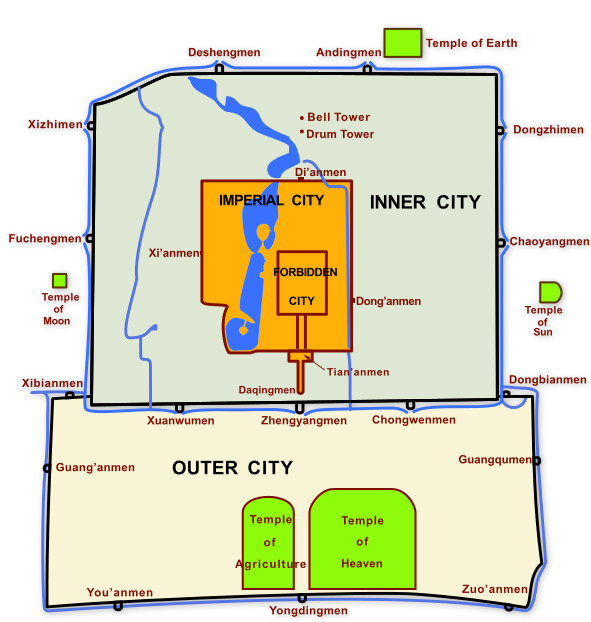Central axis shapes backbone of Beijing

Beijing city in the Ming and Qing dynasties was divided into two walled sections, connected by gates.
Hidden behind Beijing’s hustle and bustle of crowds and busy streets, there is an imaginary axis running through the lives and geography of residents. Although it has never been marked on maps of Beijing, it has existed for more than six centuries. It is the city central axis of Beijing, also known as the traditional central axis of Beijing City, which is regarded as an icon of the city and the “backbone” of Beijing. This 7.8 kilometer-axis was seen as a royal line or “dragon’s vein” in ancient China.
Many scholars think that the construction of ancient Chinese capital cities reflected a common pursuit of the central axis, which has a long-standing and profound history in China. In Mister Lü’s Spring and Autumn Annals, it is recorded that ancient Chinese kings chose the center of the world to found a state and established a palace in the middle of the state. It is generally acknowledged that this idea is closely connected with Chinese people’s deliberate pursuit of symmetry of the central axis.
Academics have various opinions as to which city was the first to have a central axis. One contender is Yecheng City in modern Hebei Province. During the period from the Three Kingdoms to the Northern Dynasties, Yecheng City inherited the city pattern of the Qin and Han dynasties and then evolved during the Sui and Tang dynasties.
Its design philosophy of the central axial symmetry and clear city function division was adopted by later dynasties and exerted a far-reaching influence on the layout and construction of ancient Chinese capital cities and even ancient capital cities in the East Asian region. The emergence of a neat and precise central axis in Chang’an City, the capital of both the Sui and Tang dynasties, further advanced the city layout of Yecheng City.
The construction of Beijing City under the Ming and Qing dynasties started in 1406 and was finally completed in 1420. This Imperial City endured 14 years of construction and became a majestic capital city built on a central axis. In the center of the Imperial City is the Forbidden City, which was the palace of 24 emperors from the Ming Dynasty to the Qing Dynasty. The Imperial City is enclosed by the Inner City and the Outer City was established in 1553 to its south. Its design inherited the concept of the central axis from the Yuan Dynasty and extended it from south to north. This central axis starts from the north at the Bell and Drum Towers and ends in the south at Yongdingmen Gate.
From south to north, the central axis passes through Yongdingmen Gate, Tianqiao, Zhengyangmen Gate, Wumen Gate, the Forbidden City, the Longevity Pavilion atop Prospect Hill and finally reaches the Bell and Drum Towers.
The central axis of Beijing is a masterpiece of ancient city planning and received extensive praise from Chinese and Western scholars. American architect Edmund Bacon once described Beijing as “possibly the greatest single work of man on the face of the earth.”
